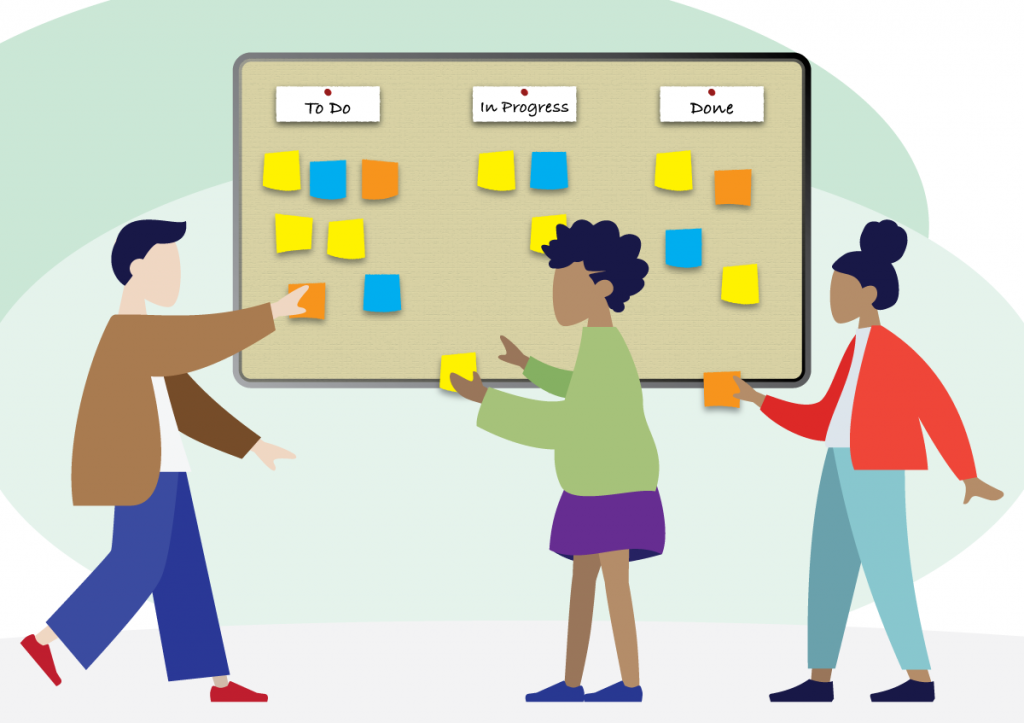Chapter 11 – Agile PM
11.7. Scrum Process and Meetings

We live in a fast-paced world. It is highly competitive in the world economy. Organizations need to move with speed and be flexible. Hence the need to shift away, somewhat, from traditional project management. The scrum process is considered a holistic approach, similar to the game of rugby. It is a faster way to develop new products and services. It tends to be creative and market driven. Traditional project management is sequential. In the scrum approach the steps are segmented where the customer is highly involved, and several people are involved with varying skills at different times.
The hand-picked team, decided by Human Resources and other stakeholders, is a multidisciplinary team. This team, self-organized, holds a series of meetings to work through the project. The project goes through several phases. The phases may even overlap sometimes. The team can stay in close touch and respond quickly. The project is a continual trial and error process through meetings and development.
HR in Focus: Human Resources and Training in Scrum Meetings
With the new approach being popular, Human Resources would be training project managers and team members in the foundations of Agile Management and the Scrum process. One of the best ways to train Scrum Meetings is through lectures of the process, videos “mirroring” a Scrum Meeting; and role plays where the team can participate in a mock Scrum Meeting.
Scrum Meetings
Release Meeting: Establish the goals and broad plan for the project. The team decides how the project will be completed and the expectations. The meeting may include risks, features to be developed and backlog. A backlog is the amount of work a member commits in a certain amount of time before the next sprint. It is a list of everything that needs completed that is distributed to the team.
Sprint Planning: At the beginning of each sprint, the Product Owner and the team negotiate where to start, which features are most important to least important, and who is responsible for each component. They also decide on how long it will take to complete the sprint. The team works with the team to break down the pieces of the project. Everything is recorded. The goals cannot be changed once the sprint is over.
Daily Scrum: This is the core of Agile project management. There are daily meetings which are called “scrum.” Every day, at the same time, in the same place, the team meets (usually standing and sometimes in a circle) and take turns answering important questions:
- What happened since we last met?
- What are we going to be doing between now and the next Scrum?
- Are there any obstacles, and if so, what are they?
These meetings only last 15-20 minutes. Everything is written down on a whiteboard, and recorded later. Meetings must start on time, it is limited in time, and only the core questions are answered. After the meeting, some of the members may meet to work out the obstacles. The purpose of the daily scrum meetings is to quickly find out what everyone has done since yesterday, what you are going to be doing between today and tomorrow, and what could stop you from doing what you are doing. The team decides what they will do, not the Scrum Manager. The Scrum Master ensures the logistics of the meeting are handled.
Sprint Review: At the end of the scrum meeting, if there is a sample of the product/service to “show and tell”, the members show their specific work. They ask and receive feedback related to changes, improvements; and are praised for their work to date by the team. The product owner may approve work done to date.
Sprint Retrospective: The team reflect on how well they think the last sprint went and set up an action plan to improve, if necessary. The Scrum Master facilitates the meeting. The team is always working toward continuous improvement of the project.

